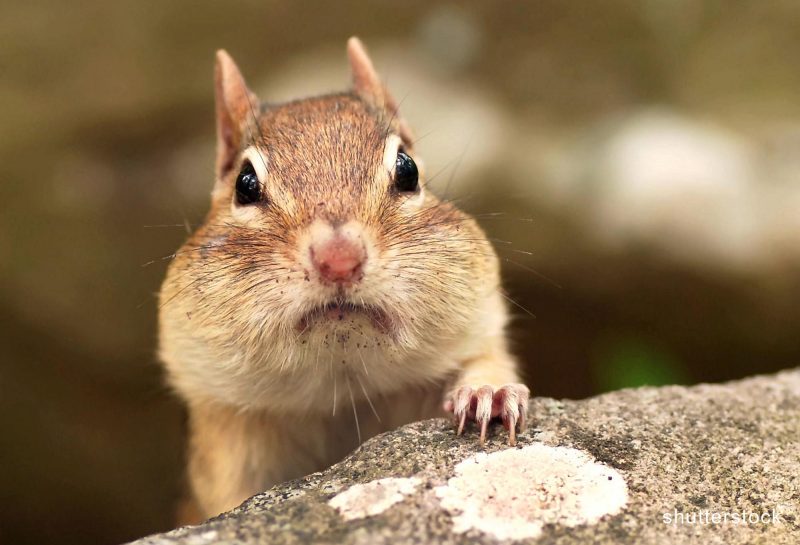Now is the time of year when the woods are alive with chipmunks, busying themselves collecting beechnuts and acorns to cache in their burrows for the coming winter. Now is also a productive season for forest hawks, hoping to swoop down and snatch-up unwary chipmunks that are pre-occupied with gathering food. But what is most interesting for us nature-listeners is that chipmunks respond to hawk fly-bys with a special “aerial predator alarm call” … a hollow, resonant cluck … cluck … cluck … cluck … cluck … that is unmistakable. It sounds like this:
An Eastern Chipmunk giving cluck calls. 7:30am, 8 August, 2016, Land Between the Lakes, Kentucky. © Lang Elliott.
What’s even more interesting is that the clucking is contagious; if one chipmunk begins clucking, others will soon join-in. Before long, the whole forest comes alive with clucking, and the clucking may continue unabated for many minutes. Here’s a recording I made last weekend. Quite a chorus of “clucking munks”, don’t you agree?
A large group of Eastern Chipmunks clucking, with drip from the trees. 8am, 25 September, 2017, Shindagin Hollow near Brooktondale, New York. © Lang Elliott.
I studied this phenomenon while I was a graduate student at the University of Maryland, my thesis being The Social Behavior and Foraging Ecology of the Eastern Chipmunk (Tamias striatus) in the Adirondack Mountains, published as a Smithsonian Monograph in 1978). In my opinion. a chipmunk need not actually see a hawk to begin clucking — it only needs to hear other chipmunks sounding of and it will follow suit.
 During my field study, I observed Broad-winged Hawks flying through understory on numerous occasions. In every instance, chipmunks responded with clucking, their calls erupting through the forest along the flight path of the hawk (usually there was a slight delay in response, a chipmunk perhaps not beginning to call until it was certain the hawk wasn’t coming directly for it).
During my field study, I observed Broad-winged Hawks flying through understory on numerous occasions. In every instance, chipmunks responded with clucking, their calls erupting through the forest along the flight path of the hawk (usually there was a slight delay in response, a chipmunk perhaps not beginning to call until it was certain the hawk wasn’t coming directly for it).
The function of the clucking is probably twofold. First, the clucks alert other chipmunks that a hawk is in the vicinity, making them far less likely to be captured. A second function is that hawks are probably deterred by all the vocalizing. Clucking chipmunks usually perch motionless and alert on a log, making them almost impossible for a hawk to catch (they will instantly jump for cover if a hawk does indeed head for them). Thus, a lot of clucking probably discourages a hawk and causes it to move from the area.
I love to hear all the clucking during early autumn. It tells me that the chipmunks are doing well, that’s there’s lots of food for them to gather, and that the hawks are getting their share of the action. I may feel sad for the unlucky chippies that become hawk food, but I am nonetheless happy to hear them sounding off and have some notion of what the fuss is all about.
 Friends … if you find that my blog has a positive impact on your life, please help support my effort by making a modest donation.
Friends … if you find that my blog has a positive impact on your life, please help support my effort by making a modest donation.





Just heard a clucking sound and looked up “Eastern bird that makes a clucking sound”.
Thank you for the answer and recording: it is exactly what I heard. Moments before the clucking began a local hawk had been sounding his cry. All makes sense!
I do climate and biological research in the High Knob Massif of western Virginia, in the southern Appalachians, and conditions above 3000 feet (in what I define as the upper elevations) are analogous to the Great Lakes and lower elevations of New England, with northern hardwood forests and abundant chipmunks. I have heard this mass clucking many times. I agree with Lang, and also believe this to be an evolutionarily developed, adaptive strategy that increases the odds of escaping being caught by a predator for any given individual. The reason, of couse, being that this mass clucking makes it nearly… Read more »
After the above comment, I went back and reviewed Lang’s thesis (it had been a good while since I read it). I then remembered that Chipmunks are not really considered to be social, despite being so abundant in northern hardwoods. This does not change, however, my observations that makes me believe this mass clucking is advantageous. One behavior I have been interested in that is perhaps taken for granted, is their tendency to rise up on their hind legs to survey the surrounding environment. This is risky in that it can make an individual more visible. I reason this behavior… Read more »
Wayne: I agree. The advantage of getting a better look at one’s surroundings outweighs any disadvantage (eg. getting spotted by a predator).
Plus … even though chippies are rather asocial (each having its own territory, though lots of overlap between territories), neighbors are quite likely to be related to one degree or the other … so we end up with a kin selection argument for what appears to be altruistic behavior (though “low cost” altruism for sure, given that an alert, perched chipmunk would be very difficult for a hawk to snag, there being no surprise element, and assuming the chipmunk is quite ready to retreat into a nearby shelter should a hawk attack).
Why do they do this in the fall and not all summer? The hawks are here all summer and fall and we only hear the clucking in the fall.
Jeane:
Two possibilities. First and foremost, autumn is a hugely busy time for chipmunk because they are gathering food for the winter, which they store underground. Also, both beechnuts and acorns ripen at that time. Secondarily, as the leaves drop, hawks become much more visible, which makes it easier for chipmunks to spot them.
In the summer, chipmunks are much less active, in part because they become infected with botfly larva, which researchers guess makes them sick. So they spend more time in their burrows until the adult botflies finally exit and the wounds heal.
I have a small wooded section in my property and chipmunks were active all summer and I did hear the clucking choir :-). In fact there is one going on right now, which prompted me to look this up. But I have noticed more activity this month of September, as Lang mentions. Food gathering is in full swing by chippers and squirrels as well.
Fascinating! I had no idea that this is why chipmunks cluck. I am going to quote a bit of this article for a YouTube video I’m making (I will be sure to credit you Lang).
I am listening to the clicking as I write this…my house is surrounded by tall pines and…you guessed it…a hawk’s nest!
Thanks for solving this long-standing mystery for me! I hear this outside my window often and during area hikes here in north Atlanta, GA. Of course multiple attempts to see the ‘bird’ that caused it failed. Yes, we do have both chipmunks and hawks all around. Now I know to ‘look down’ 😉
Seeing what sets off the clucking is difficult because the hawk is usually long gone by the time a chipmunk starts calling. Sometimes, though, the hawk will be perched and if you walk toward a calling chipmunk you might be lucky enough to spot it, especially as it takes flight.
We frequently hear these chipmunk alarm calls at our state park, but I have to admit one chippie once fooled (and embarrassed) me- I though it was a yellow-billed cuckoo bird!
That’s funny, but I can certainly understand how the two could be confused.
That was my first thought today, also, but I realized the sound was coming from the bushes and not the treetops where cuckoos tend to spend their time. I crept up and saw the chipmunk. I’d definitely heard this call before, but now I’m happy to know who’s calling, and, thanks to this article, why. I was also interested to learn about botfly infections, having noticed so few chipmunks from the family that lives under my porch steps this summer, I thought a neighborhood cat must have clears them out. They like my yard because of the bird feeders. But… Read more »
Thank you for the new clips,I always enjoy getting them. They make life so much brighter in this troubled worldwe live in. Thank you Lang for all you do.
Wow, i would have been way off guessing what that noise was. One of many. LOL
That was amazing! I knew the sound to be chipmunk’s. I’ve saw one sitting on a stump one time and clucking away. But I’ve never heard more then one at a time. I LOVE the second clip with so many clucking. That was so cool! I had no idea what they were doing it for. Thanks for filling in the blanks.
With regard to the second clip, I too had not heard that many going at once, at least with individuals so close-by. Perhaps the population levels this year in my area are much higher than normal.
I have often heard this clucking sound while hiking and wondered which critter it was coming from and now I know. Thank you Lang. I’m glad you are back in touch. I was beginning to worry.
And thank you for chiming-in Carlene.
Hi Lang. Thank you! This was SO interesting. There are so many sounds that I (and I’d bet most of us reg’ler folks) encounter all the time in nature and have no clue about what’s making them. Just last night I was listening to a very distinct loud and rhythmically repeated buzz (with jazz variations) from high up in a Cottonwood tree, wondering what kind of (presumably) bug it might be making it, why don’t I already know that for Pete’s sake, and how could I find out. Speaking of which, are recordings made with nothing but a cell phone… Read more »
Glad you like it Jennifer! And yes, cellphone recordings are often quite good enough to make an ID. So if you hear that bug again, please make a recording and send it to me.
So interesting. Glad to see you are posting sounds again 🙂
Thanks Chris! Hope you’re doing well.
Love this! Thanks!
Ever heard it before? Most folks don’t know who is making this call, nor do they know what it means … even though it is of common occurrence throughout much of the East.